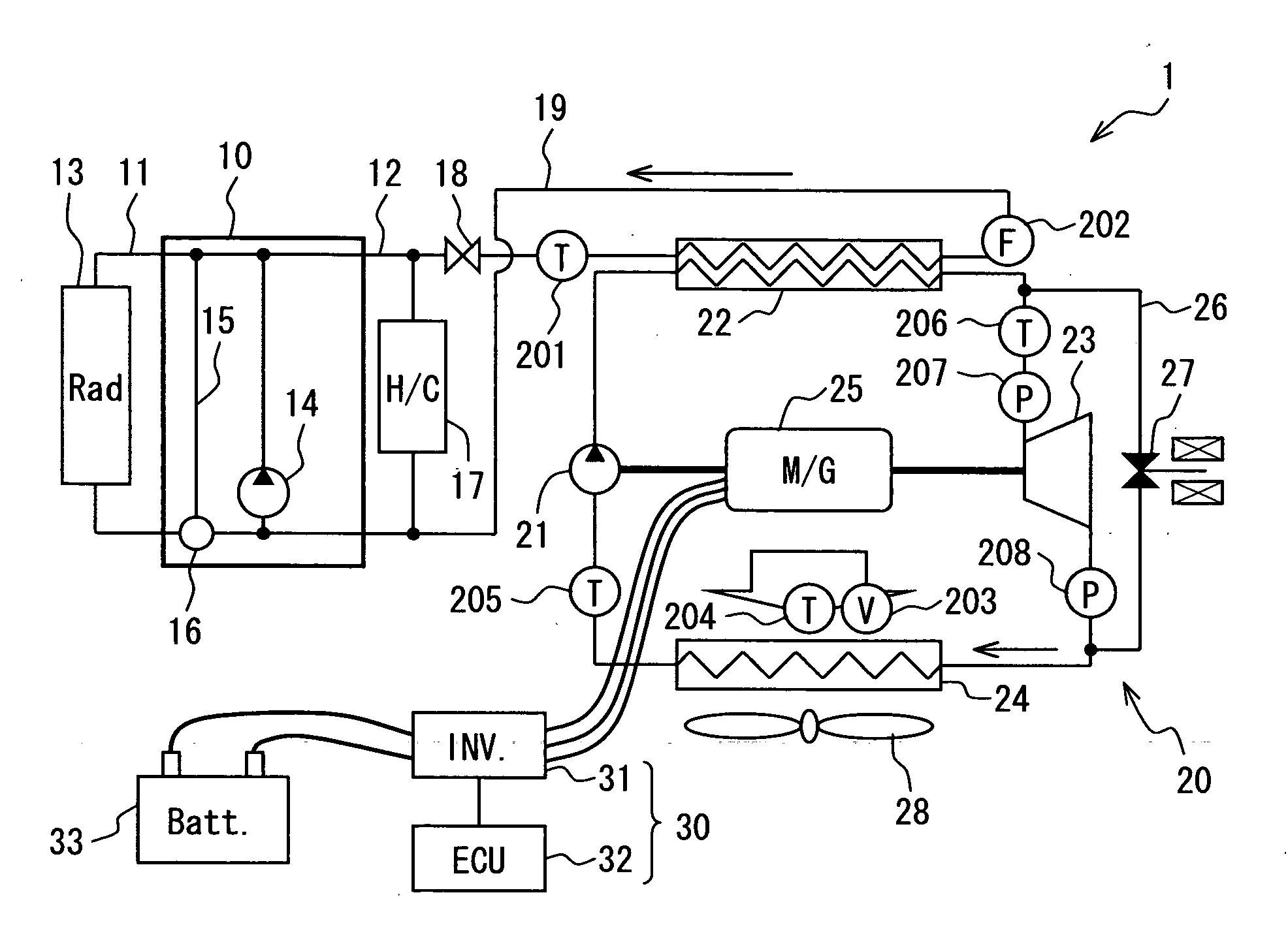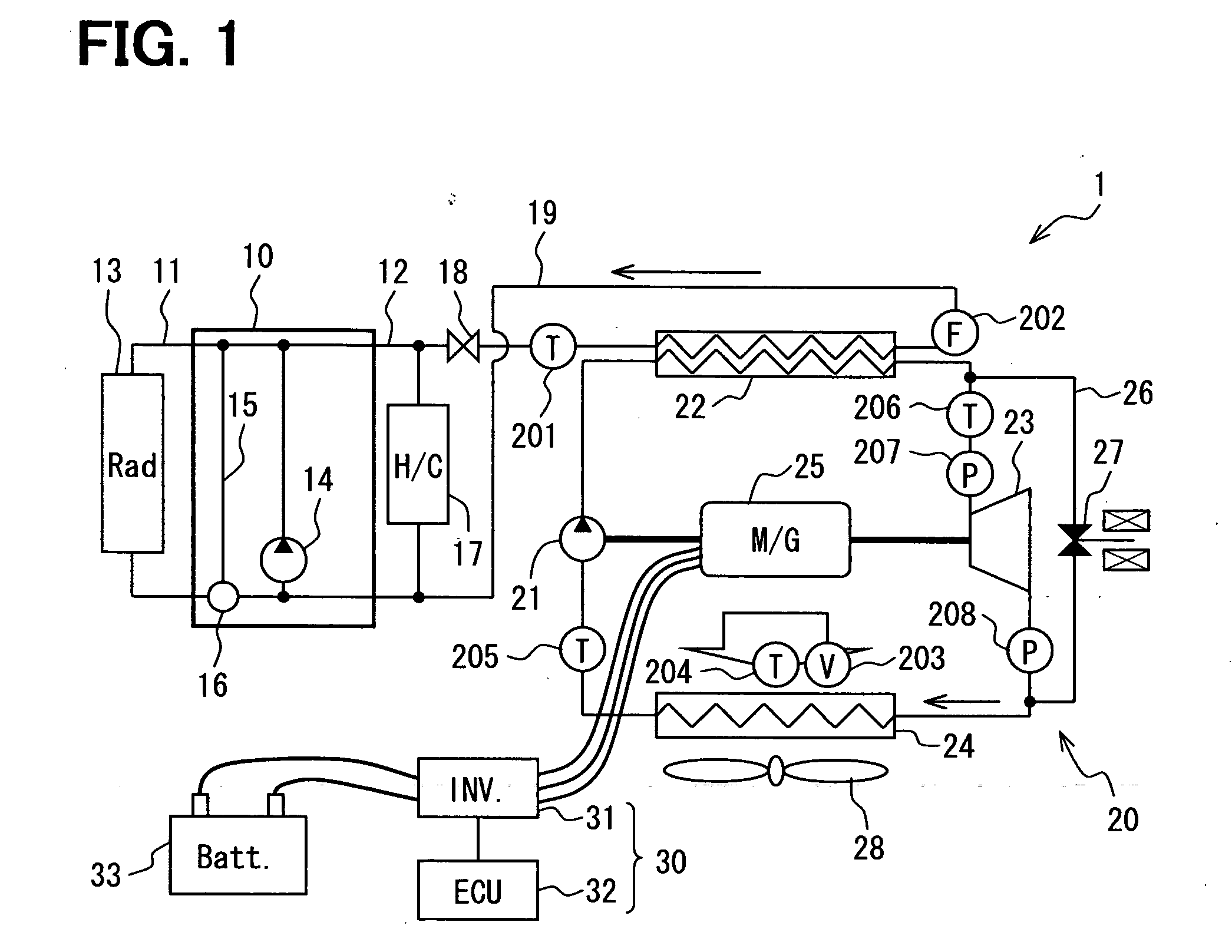Waste heat recovery apparatus
- Summary
- Abstract
- Description
- Claims
- Application Information
AI Technical Summary
Benefits of technology
Problems solved by technology
Method used
Image
Examples
first embodiment
[0046]A first embodiment of the present invention will now be described with reference to FIGS. 1 to 11.
[0047]FIG. 1 is a diagram schematically illustrating the whole system of a waste heat recovery apparatus 1 having a Rankine cycle 20. As shown in FIG. 1, the waste heat recovery apparatus 1 of the present embodiment is applied, for example, to a vehicle that uses an engine 10 as a driving source.
[0048]The engine 10 is a water-cooled internal combustion engine. The engine 10 is provided with a radiator circuit 11 for cooling the engine 10 by circulating the engine-cooling water, and a heater circuit 12 for heating air to be conditioned by using the cooling water (hot water) as a source of heat.
[0049]A radiator 13 is provided in the radiator circuit 11. The radiator 13 cools the cooling water circulated by a hot water pump 14 by exchanging heat with an external air. The hot water pump 14 may be either an electric pump or a mechanical pump. A heater 22 of the Ranking cycle 20, which ...
second embodiment
[0125]Next, a second embodiment of the present invention will be described with reference to FIGS. 12 and 13. In the present embodiment, steps common to those of the first embodiment are denoted by the same reference numerals as those of the first embodiment, and described below are portions different from those of the first embodiment.
[0126]FIG. 12 is a flowchart illustrating the Rankine operation control (S4) according to the present embodiment in detail. In the present embodiment, the Rankine operation control (S4) has a maximum / minimum rotational speed setting step (S411), which is different from the first embodiment. The constitution of devices and other controls are the same as those of the first embodiment. Therefore, described below in detail is the maximum / minimum rotational speed setting step (S411), and other portions are not described again.
[0127]Referring to FIG. 12, at step S411, an increase or decrease of the maximum rotational speed Nmax_s of the expansion unit 23 is...
modified examples of first and second embodiments
[0138]In the above first embodiment, the pressure information P as the low-pressure side condition was the outlet-side pressure Pex_out of the expansion unit 23. Instead, the pressure information P may be, for example, a differential pressure ΔP (inlet-side pressure Pex_in—outlet-side pressure Pex_out) between the pressure Pex_in on the inlet side and the pressure Pex_out on the outlet side of the expansion unit 23. In this case, the diagram of characteristics shown in FIG. 14 can be used, in place of the diagram of characteristics explained in FIG. 8, to obtain the same effect as that of the above first embodiment.
[0139]In the diagram of characteristics (FIG. 9) in which the battery voltage is taken into consideration at step S44 (see FIGS. 6 and 12) in the first and second embodiments, the command rotational speed N_id may be continuously varied instead of being varied stepwise. In this case, the diagram of characteristics shown in FIG. 15 can be used. When the battery voltage lie...
PUM
 Login to View More
Login to View More Abstract
Description
Claims
Application Information
 Login to View More
Login to View More - R&D
- Intellectual Property
- Life Sciences
- Materials
- Tech Scout
- Unparalleled Data Quality
- Higher Quality Content
- 60% Fewer Hallucinations
Browse by: Latest US Patents, China's latest patents, Technical Efficacy Thesaurus, Application Domain, Technology Topic, Popular Technical Reports.
© 2025 PatSnap. All rights reserved.Legal|Privacy policy|Modern Slavery Act Transparency Statement|Sitemap|About US| Contact US: help@patsnap.com



